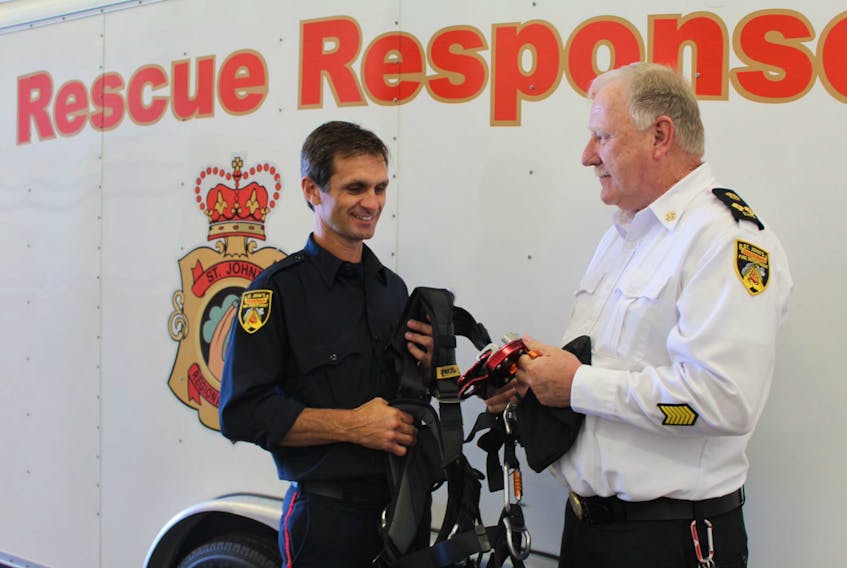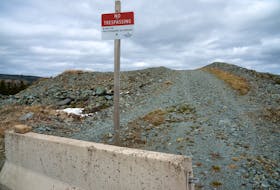ST. JOHN'S, N.L. — The old lore about firefighters getting called out to rescue cats has been eclipsed by dogs in peril.
But there’s a serious message in the two or three incidents a year that St. John’s Regional Fire Department crews get called to safely pull a dog from a cliffside, out of icy waters or from other dangerous situations.
If you’re out with your dog along a dangerous trail or, in the case of winter, an icy pond or waterway, think twice about off-leash activity.
It can end in a call for high-angle or cold-water rescue.
Most often the dog rescues are successful, but the situation puts them in risk of tragedy. Any well-behaved dog can slip or take off after a bird or squirrel without thinking about the treacherous terrain.
“The way we look at it is that animals today are family members. There’s no doubt about it. And the same way you wouldn’t leave a child running across the trails by themselves, we have to remember that dogs need to be taught how to keep themselves safe,” said Deputy Chief of Operations Richard Mackey.
Some owners think their pet's wolf instincts kick in out in the wild of the woods or trails, but dogs are so domesticated and used to life inside the house, they aren’t as surefooted as people think when it comes to tricky trails.
“People automatically assume their dog is going to know how to work in a rough terrain,” Mackey said.
“They get themselves in predicaments and they just don’t know how to get up out of it. Those types of things are getting more and more frequent.”
Mackey, a 32-year veteran of the fire department, said two to three dogs each year are rescued, whether they crash through the icy water at Quidi Vidi or other ponds — often enticed out onto the ice by seagulls — and require cold-water rescue, or get stuck on a cliff and require the high-angle team.
As more and more people are drawn to jaw-dropping views along the coast and hikes such as the East Coast Trail, naturally they bring their dogs along for the trek.
Keeping them on a leash and safe should be a priority, and Mackey even suggested people use a harness on their dogs along treacherous trails.
“The dog has to be on a tether of some sort when they are walking over trails. People love to let their dog run free. I get it. That’s why we have dog parks, so the dogs can exercise and run freely,” Mackey said. “But unfortunately, with so many coastal areas and so many people being introduced to these trails, a lot of pets don’t have the understanding of the dangers that are on those coastal trails, where an adult or human would be able to see, ‘OK, I am not going near that cliff edge.’ Pets quite often don’t comprehend the danger that is in front of them.”
When a dog needs the high-angle team, typically the resources are doubled up as, unlike humans, they may need distracting and comforting while the rescue team fits on a harness.
“They almost sandwich the animal so they can’t run further away,” Mackey explained.
Currently the fire department uses human harnesses during dog rescues and would welcome any contribution of proper animal/dog rescue harnesses from volunteer groups.
“We make do with the human stuff. The help harness is a pretty versatile piece of equipment,” Mackey said.
Dogs can be squirmy, and they have four legs, not two, so the right equipment would be a better asset.
The human help harnesses cost $1,400.
Previously the fire department received a donation of small masks for dogs and cats rescued from fires and needing treatment for smoke inhalation, and they are now standard department equipment.
Although highly trained, each time the high-angle teams — there are 32 firefighters trained in the skill across the department — go out, they are heading into unpredictable situations.
‘Every time you go over the cliff you are going into a new situation. A whole new set of problems could arise for you down at the bottom of the hill. … It sharpens your senses,” said Mackey, who has been a member of high-angle rescue teams.
“We do leave it to the team members to determine how far they will go. But with our level of training, we can put ourselves in some awful, awful strange spots.”
Frightened and injured dogs have nipped or bitten their would-be rescuers, so heavy leather gloves are an important part of the equipment.
The most recent rescue was Regatta Day, when a dog named Finnegan wandered away from a home on Doran’s Lane in Logy Bay-Middle Cove-Outer Cove and ended up on a cliff off the East Coast Trail.
Capt. Gina Burke was co-ordinating the resources that day.
"They heard the dog barking,” said Burke, who noted in the beginning it wasn’t known if there was a person in trouble as well (there was not).
“For some people, dogs are the children. We end up treating the animal just as importantly, pretty much on the same scale as a human.”
Firefighter Chris George was at the scene.
He said the beagle mix had gone down the shore and somehow found himself about 250 feet down a cliff from the trail and was perched above the water on a ledge, which required a free-fall by the rescuers.
George went halfway down, while Ed Coady of Kent’s Pond harnessed the dog.
“He sort of cuddled right into Ed. … He was very happy to see help. … All of us out there were pretty much dog lovers, so it was nice,” George said of the happy ending.
“He was in a queer spot.”
As a group of firefighters sipped coffee on a break at the Central Fire Station on Parade Street, they agreed dog rescues by far outpace cat rescues.
And they said pretty much everyone has had a hand at rescuing someone — human or dog — from Outer Cove, indicating the need to be careful on trails.
Meanwhile, between 2004-18, there were five rescues of dogs at Parks Canada sites across Canada, none of which were in Newfoundland and Labrador.
[email protected]
Twitter: @BarbSweetTweets









